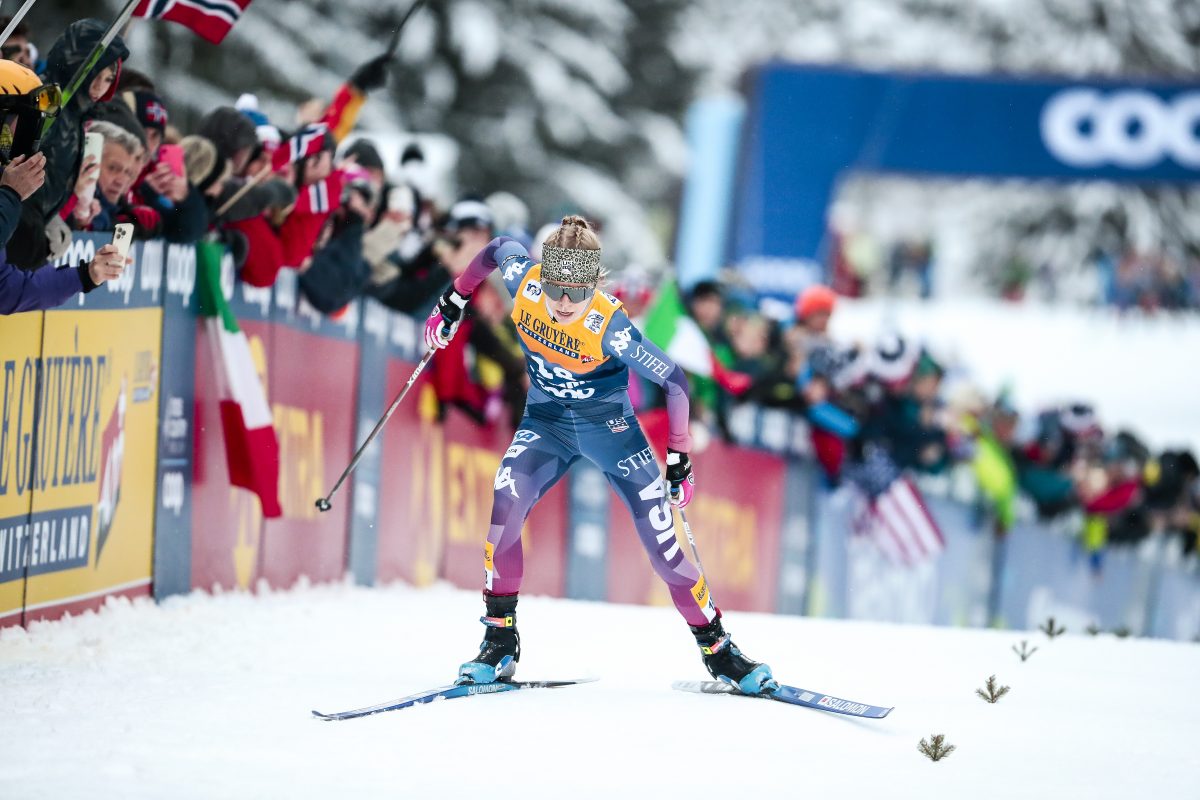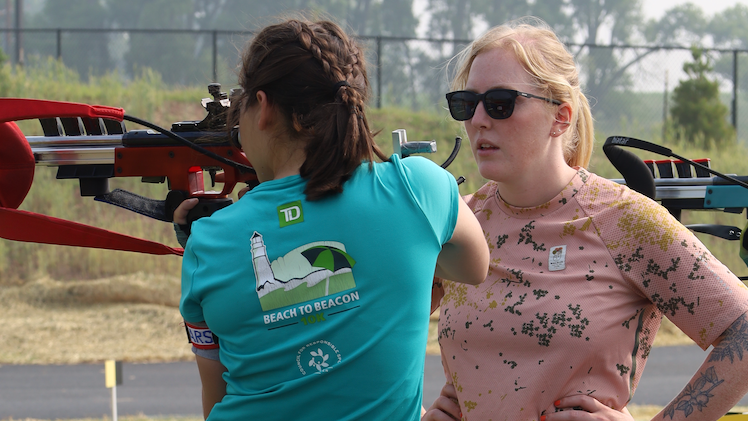
Last winter, a number of relatively young American athletes catapulted their way to top-ten World Cup results in nordic disciplines – often very much to their own surprise, and certainly to the surprise of European commentators. One of those was Stockholm, Maine’s Russell Currier, who, joining the biathlon circuit halfway through the season, had a breakout performance in his second race of that weekend.
In a sprint in Nove Mesto, Czech Republic, 24-year-old Currier started more than half an hour after eventual winner Emil Hegle Svendsen of Norway finished – but the announcers couldn’t coast through the back half of the field, because, out of the blue, Currier charged his way towards the podium, ultimately missing it by nine seconds and placing sixth. He repeated that result a few weeks later in Kontiolahti, Finland.
This summer, Currier had reason to gain a little spring in his step – and so did his home club, the Maine Winter Sports Center.
“Russell has been with us literally from day one,” said MWSC President Andy Shepard. “When we started our Healthy Hometowns program in 1999, we decided to start off small with one or two or maybe three communities, to really figure it out and nail it and then we’d start to expand it. One of the first communities we were in was Stockholm, Maine. Russell was in that very first class.”
MWSC has had plenty of standout athletes in the past, but Currier is the first to go all the way through the program from Healthy Hometowns to the first page of World Cup results – something that Shepard says he wouldn’t have believed a decade ago.
“Nobody who knew Russell at the time would have imagined he would grow up to be a world-class biathlete,” he laughed in an interview from Park City. “He was your typical middle school kid. He didn’t look like a world-class athlete and he didn’t act like a world-class athlete. But he started skiing to and from school, he spent a lot of time hanging out with our coaches, and really from day one he has embraced this notion of living a healthy, active, outdoor lifestyle, and it has changed his life as a result.”

Shepard said that Currier’s recent success was another boost to the program, which uses its elite athletes to inspire younger kids to get outside and be active. Having one of the most successful of those athletes come from just down the road? It helps.
FasterSkier caught up with Currier to check in about his summer training, whether the 2012 results have changed his approach, and what he’s working on for 2013.
FasterSkier: How has your summer gone?
Russell Currier: It’s pretty busy. I’ve spent a lot of time over here at the Olympic Training Center in Lake Placid, based out of there. I spent a few weeks back at home, but not too much. It’s a good training group and a good system – a little repetitive at times, but it works pretty well.
FS: Northern Maine and Lake Placid are a pretty long drive apart, so how does it work to try to split your time like that?
RC: If I’m going to be in one place, I try to be in one place. In the past I have spent the low weeks back home, but this summer even in the rest weeks I would stay in Lake Placid because it’s a solid eight- to ten-hour drive back home, and it’s not very exciting. If I can dodge that, it’s almost always worth it. It’s been like this for I’d say the past three years.
FS: With Kris Freeman and Annelies Cook coming on board at MWSC, has the training dynamic changed there at all?
RC: It’s hard to say, just because I haven’t spent enough time at home. The cross country team has its own schedule, so we’re not all in the same place at once. I think for sure it has been great to have those guys, but I wish I could say that I spent more time with the group as the whole to see. With this kind of lifestyle, everybody is on different pages.
FS: It’s definitely a lot of travel. Was last year the most continuous time you had spent on the European circuit?
RC: Yeah. That was by far the longest. It wasn’t too hard on you, bouncing around central Europe, but at the same time, if you can do it then that means you’re on the circuit and you’re on the team, so it’s a fair trade. It’s going to set the bar higher for next year, and I think it was a good confidence booster.
FS: Have you thought more about why you had such a pickup in results, and whether it has changed anything?

RC: We’re always trying to find where to make up time, by any way. Last year the coaches and I just sat down and basically did that – we said, what can we do to up my shooting percentages and to keep ski speed going? This year we have done the same thing. We have worked on transitions a little, improved technique, done all sorts of mechanical work on the rifle and really pushed that whole process, both prone and standing. So it’s the same formula, just constantly trying to move forward with it I guess.
FS: Do you have any goals for this season – big events? Consistency?
RC: Nothing too specific, unfortunately. I would just like to get as close to having a little more consistency as I can, being safely on the circuit, and jumping into that top-40 points range as much as I can, instead of past years just trying to stay on the World Cup circuit and going back and forth – being home for February, then being gone. This year I want to be in a more consistent, safer spot.
FS: Are you pre-qualified for the Sweden trip, or do you still have to go through trials for that?
RC: No, I actually got my plane ticket yesterday.
FS: Is it a relief to at least know that you’re starting over there with the team?
RC: Yes, absolutely. Last year there was pressure going into the races in Jericho and Utah. You have to switch up your training a little bit. This year, to not have that stress is a nice bonus. You can just train right through it and it’s not an issue if you’re tired on the day of a time trial in October.
FS: Since your results this winter, do you have any more resources at your disposal? More sponsorship?
RC: Not that much. Nothing financially, at least not from up north. But it’s nice coming from a small town, because everybody was more than excited whenever I had good results. Whatever time I spent home was great just to be able to catch up with everyone.
FS: I would imagine that finally coming home after that trip, you must have had quite the welcome.
RC: It was. I wish we’d had some more snow.
FS: In terms of current events, one big thing that has happened is obviously the Lance Armstrong case. What has that meant to you?
RC: I think we all had our suspicions. When we were younger, he was definitely one of our sport heroes, and then in the last few years, at least from my perspective, that has kind of changed and now this certainly backs up that change in perception. But it’s interesting – unless you’re right in that mix, you’ll never get the full scope of what’s going down. All we have is what we can read from media and the articles. You kind of have to take it with a grain of salt. It’s interesting to watch and try to keep up with it.
FS: Do you think it has any implications for your own sport?
RC: It makes you wonder. The general assumption is that it is much cleaner – we’re in a good place. But for sure, we’re not perfect, and there’s people getting busted here and there. There was a pretty good bust a few years ago. It’s there, and it sucks, but I guess I’m optimistic to think that it’s fairly clean, and certainly cleaner than it used to be back in the 1990’s.
FS: It seems like a big problem in that case was the cycling federation’s refusal to do serious testing. How does biathlon compare?
RC: There was a strong push with how strict it was and how much energy there was going towards catching dopers and that whole testing process. That actually helped out a lot. They caught a lot. With the Russians, there was a new method of EPO they were using that was so hard to detect, that finally when the standards went up they were able to bust them. Long story short, I think that testing with the IBU is better than it was, but it’s hard to say if it’s good enough or not.




One comment
nyctvt
October 23, 2012 at 8:30 am
Best of luck this season to you and the whole team.